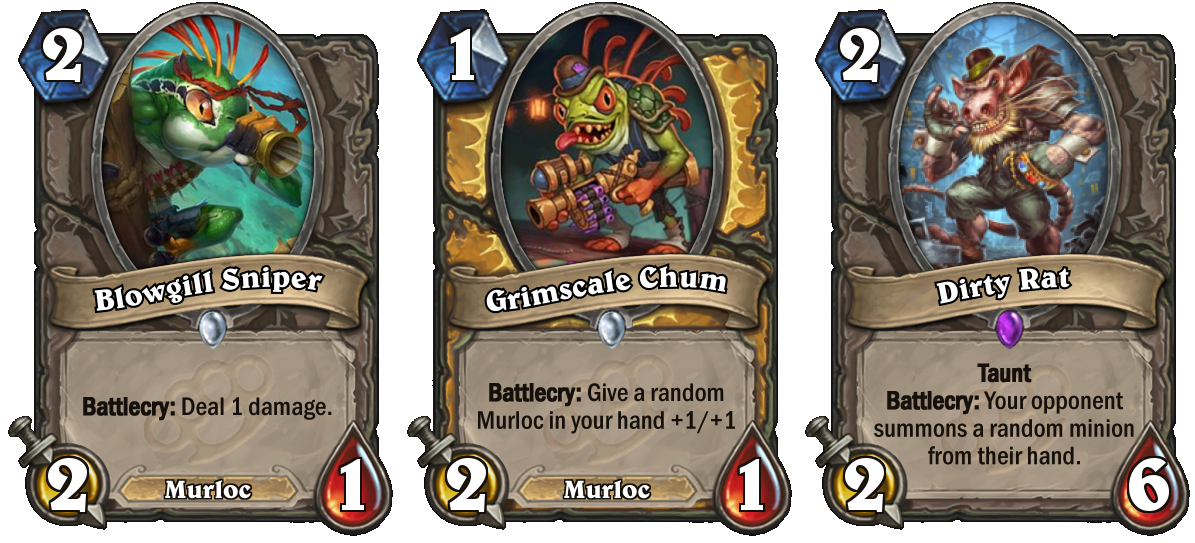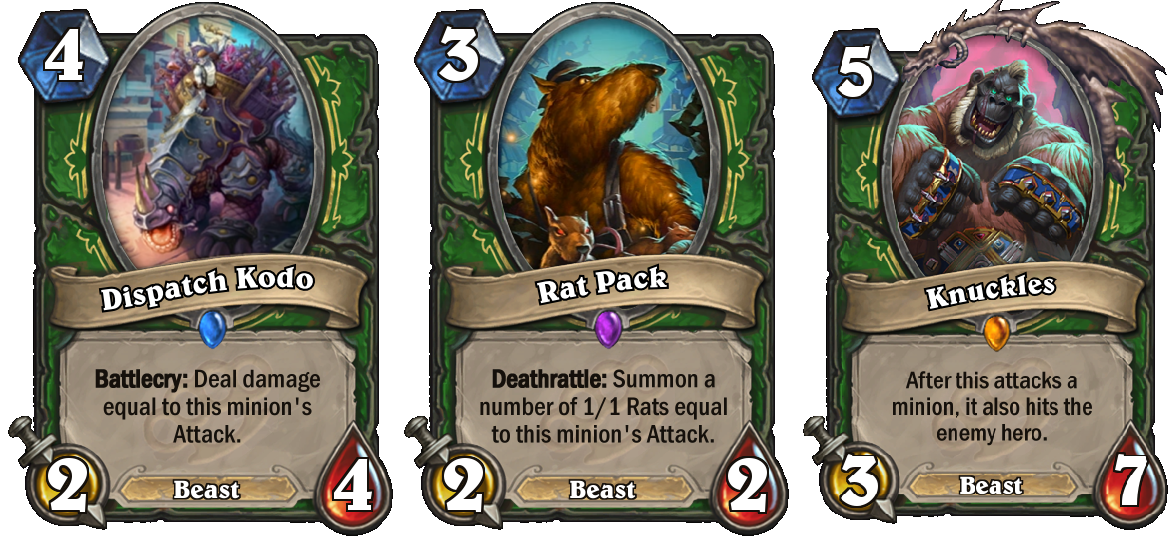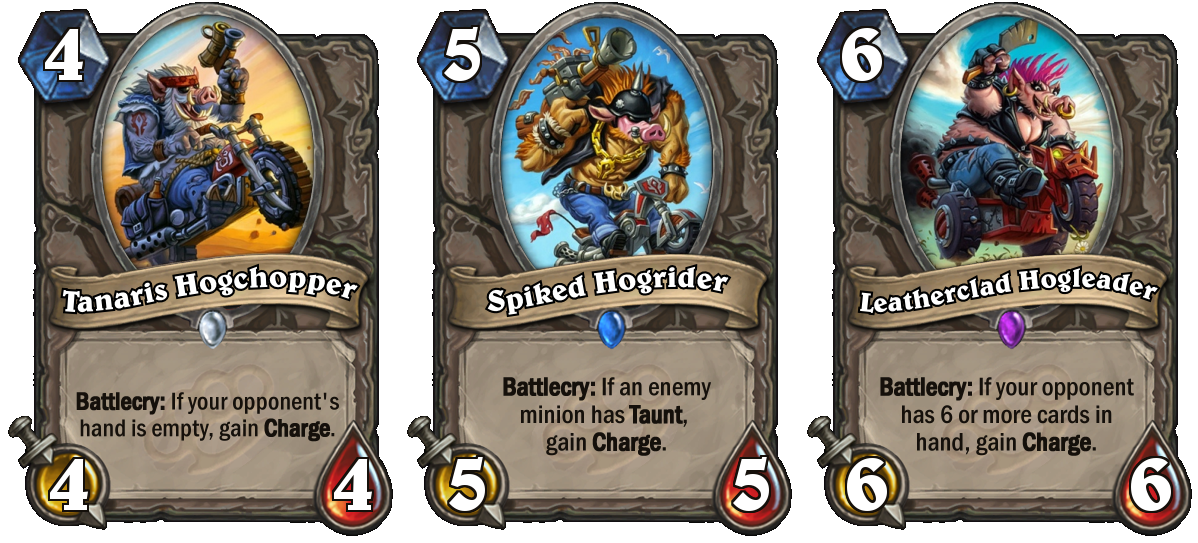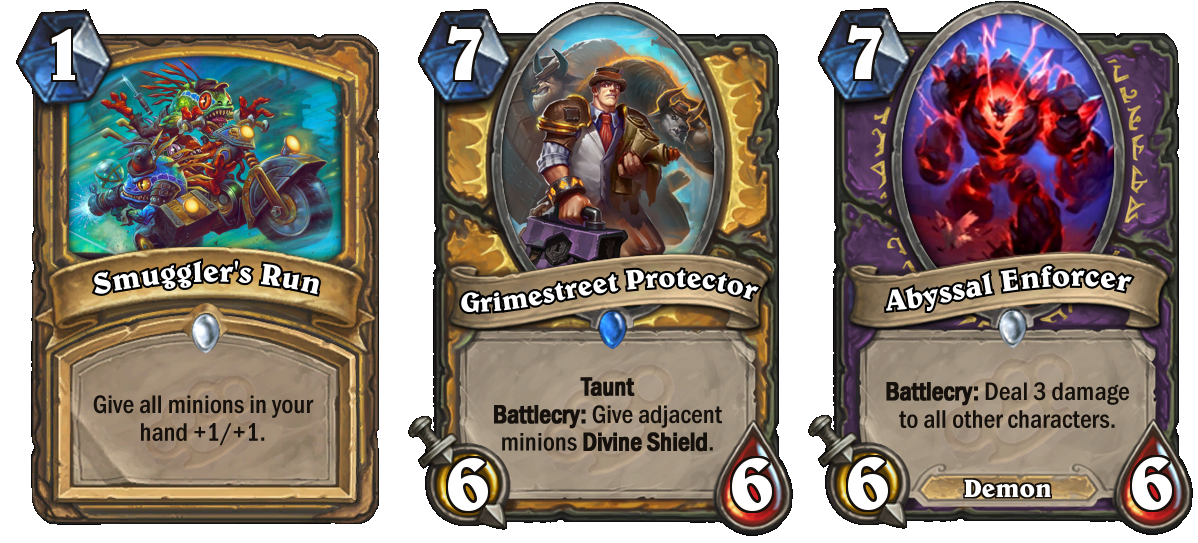In our latest roundup of cards from Hearthstone's Mean Streets of Gadgetzan expansion, we start to get farther into one of the major themes: cards that buff other cards in-hand. While these types of buffs aren't completely new -- the rarely-played Mistcaller buffed all cards in your hand and deck -- the focus on this type of effect is.
Why hand-buffing cards? They enable a longer game, rather than cards that enhance the game's tendency to become Curvestone (playing cards mainly because they fit a mana curve). It's not explicitly a catchup mechanism like pure control decks like to have, but it does give an opportunity to defer value to later in a synergistic, possibly exploitable way, perhaps taking midrange decks away from the tempo style. Will it work? The jury's still out.

Maybe there will be a Murloc-heavy deck in the upcoming meta after all? When Finja came out, I was a little skeptical. While I still am, the Blowgill Sniper is a reasonable inclusion into such a deck. The base statline of 2/1 is unimpressive for two mana, but Murloc decks only have a single card that does direct damage when being played, as opposed to buffing an existing minion on-board, Corrupted Seer. Sometimes you need that little ping and if there is a Murloc deck, it's not likely to be one of the easy ping classes. Elven Archer can ping for one, but for one more mana you get the extra point of health and the oh-so-important Murloc synergy.
If Murloc decks become a thing for Paladin outside of the bursty Anyfin-type hybrid decks, Grimscale Chum will likely make that cut. A one-mana 2/1 isn't that bad in itself, just unimpressive, but the Murloc synergies and the +1/+1 make up for it. You'll usually have a minion in your hand if you play this and if you topdeck this card, if you're topdecking with a Murloc deck and haven't sealed the win, you've probably already lost anyway.
I like cards like Dirty Rat for two primary reasons. First, I like anti-aggro tools and Dirty Rat, like our dearly departed friend Deathlord, is a high-health, early-game Taunt with a significant downside in return. Against an aggro deck, you're unlikely to be pulling a large cost minion from your opponent's hand, which is why Deathlord worked in the first place.
And secondly, I like cards that reward paying attention and understanding the meta and your opponent's hand. How many cards they mulligan and evaluating your ability to remove certain cards they may have are key to determining whether you want to be playing this card. And it's not a card that's going to be good in all metas or with all classes.

A 2/4 for four mana is a pretty poor stat configuration, but if the card has a really solid effect, it will be playable in competitive play. Keeper of the Grove was one such card, before it was nerfed to a 2/2. Is Dispatch Kodo one? If buff decks turn out to be strong enough, the upside of this card makes it playable. Just a 3/5, deal three damage card would be bonkers with a single in-hand +1/+1 buff. An old Keeper of the Grove that doesn't silence but is a Beast is almost good enough for less aggressive Hunter decks, simply because of the value of a ping to a Hunter. Even if it doesn't make a deck, you'll see it in Arena because Stormpike Commando, a five-mana 4/2 that does two damage, is sometimes around and this card is better.
I happen to think we will see that Hunter buff deck, in a large part because of Rat Pack As-is, Rat Pack isn't that much worse than Haunted Creeper (two-mana 1/2, summon two 1/1 spiders) or Infested Wolf (four-mana 3/3, summon two 1/1 spiders) and both of those cards are popular inclusions. But buffing this card instantly gets insane and as it's a deathrattle, not a battlecry, so you can even buff this with a Houndmaster, which is already in Hunter decks. Earlier-revealed cards like Trogg Beastrager are suddenly looking better.
Once upon a time, there was a terrible card named Cobra Shot, which for five-mana, did three damage to a minion and three to the enemy hero. Now, turn Cobra Shot into a minion that can do that as long as it stays alive and you have a very good Hunter legendary. It's only a single point off vanilla five-mana stats (11 points) and here you want it to be heavier in health so that you can clear the board and smOrc in the same turn.
Plus, it's a gangster gorilla, so I think I would've liked this card even if was unplayable.

Charge cards have been endlessly problematic to balance for Blizzard, with the majority of the nerfs in Hearthstone's history involving cards with Charge mechanics that were too powerful for their mana cost. In recent expansions, Blizzard has been introducing Charges that are very expensive or have significant conditions, as an attempt to balance this mechanic.
Here we have three, related cards that reflect this philosophy, the Tanaris Hogchopper, Spiked Hogrider, and the Leatherclad Hogleader. Not only does this reflect a continued bit of care with Charge but from the art, a in-depth knowledge of the Mad Max universe.
Are the cards playable in Constructed? I'd have to say no, especially for two of them.
The big daddy, the Leatherclad Hogleader, appears to exist only as a break-glass-in-case-of-emergency option if suddenly very greedy Control decks start oppressing the meta. Against a Renolock or a Control Priest, this card may be playable. But at the times at which your opponent doesn't have six or more cards, which is the vast majority of Hearthstone games in the game's history, it's just a worse Boulderfist Ogre, who never sees play in top-level tournaments. Goblin Sapper never worked and this one won't either, though you'll sometimes see it in Arena.
Tanaris Hogchopper is also likely a card you'll see in Arena as four mana 4/4s see play in Arena and you do get into topdecking battles late in the game with pure Control decks hard to assemble. But in Constructed? Nope.
Spike Hogrider might be the exception here. One of the nice things about the card is that the Charge is gained by Battlecry, which means you don't have to actually remove an enemy taunt using this minion (though you can if you choose to). 5/5 for five isn't as good a statline as it used to be with the emergence of 5/6 minions at the same cost and I think in the end it won't see Constructed play, but one has to at least consider it before rejecting it. Like Tanaris Hogchopper, you'll see this card in Arena.

I think Smuggler's Run will see play in a variety of Paladin decks. First off, you have the aggressive aggro-token Paladin decks that people will at least attempt to build because of the buff cards that have been released so far. And you also have a benefit to Control Paladin, which frequently doesn't have anything better to do in early turns as the one-mana secrets are only really good if you get a bunch of those for free.
The Grimestreet Protector is a one of the few tools that Control Paladins have got that doesn't do an even better job pushing an early-game Paladin style. Grimesteet Protector starts off missing three points of stats from a vanilla card, but the Taunt has value -- you occasionally saw non-dragon decks play Chillmaw, a Taunt with the same stats, even without N'Zoth to resurrect it laster -- as does Divine Shield. I think this card sees play in Control Paladin decks, even one that eschews the other buff cards.
Surprisingly, with more than half of the set now unveiled, Abyssal Enforcer is the only Warlock class card to be released. And it's a good one, so long as you don't plan on trying to play this in Zoolock. Hellfire has long been a staple of Handlock/Renolock decks, a four-mana card that has the same effect as this Battlecry. So this is like Hellfire that comes with a three-mana 6/6, which is an absurdly good statline. As such, this will be a staple in late-game Warlock decks and given that it's a Common, you'll see this in a lot of Warlock Arena decks.
This article is part of a series analyzing the cards in the Mean Streets of Gadgetzan Hearthstone expansion. For more, see part 1, part 2, part 3, part 4, part 5, part 6 and part 7.
